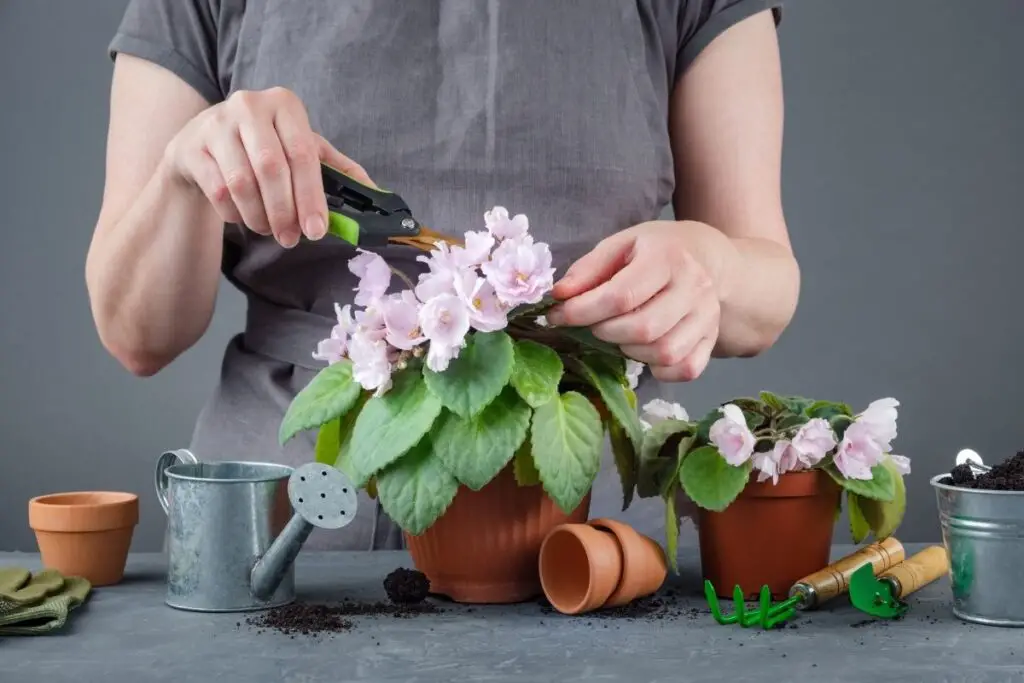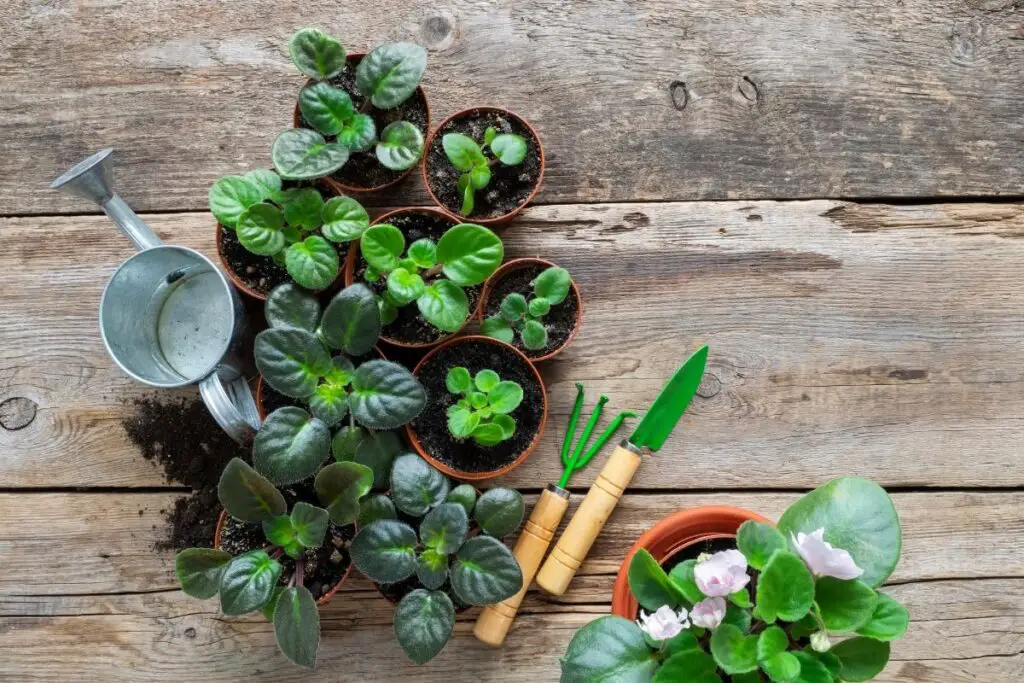African violets are popular blooming plants with fuzzy leaves and colorful blooms that are easy to care for. Pruning them is one the most critical parts of its care routine that keep them healthy and attractive.
Pruning the African violets removes or cuts the spent blooms and damaged leaves to increase their growth and blooming rate and promote new growth.
But how to prune an African violet plant?
To prune an African violet effectively, you need to do the following:
- Examine the African violet plant and look for old and dying leaves and foliage.
- Use a sharp scissor and clip off any old, yellow, or wilting leaves.
- Look out for any spent flowers and clip them off.
- Look for thick clumps of leaves and flowers and trim them up to lighten up the plant.
- Do not prune more than 25% of the total foliage.
- Water and fertilize the plant after pruning or as necessary.
- Keep the plant in a bright light spot.
Pruning never causes injury to plants, but it is a technique that uses the plant’s natural healing abilities and helps African violets achieve optimal health, beauty, and liveliness.
This article will take you along the process of pruning the African violets. We will clear all your doubts regarding the pruning aspect and provide you with care tips for your plants.

Can African violets have too many leaves?
African violets can have too many layers of leaves. Generally, 4 to 5 rows of leaves are enough in African violet plants since blooms are produced only from those leaves.
If you do not remove excess leaves from these plants, new growth will become very crowded in the center and not let the other leaves grow.
The new leaves will not get proper space to grow, and the produced leaves can become distorted. In such times, you should remove the excess foliage from the plants to maintain their health and growth.
Why is pruning important in African violets?
Pruning is an essential horticultural practice in plants.
- African violets can sometimes produce lots of leaves, and the plant might struggle to bloom due to this. Too many leaves inhibit the ability of these plants to produce new flowers.
- African violets can produce new blooms and leaves consistently. They can bloom up to nine months per year, so removing dead and dying leaves or flowers will help balance the appearance and allow new growth.
- Sometimes, the African violets get affected by diseases and pests, and at such times, you should prune to remove the affected parts of plants. Pruning becomes necessary to save the plants from these pests and diseases.
- Another reason for pruning is airflow and space. If your plants get crowded with leaves, the leaves will rub against each other and limit airflow.
- Pruning can also control unwanted plant growth, increase their flowering rate, and give them a more compact shape.
All these make pruning a necessary practice for African violets.
When to prune African violets?
Generally, houseplants are pruned at the beginning of the growing season, late winter or early spring, for many flowering varieties. But in the case of African violets, you can cut them at any time of the year whenever you notice the dead parts.
As a part of maintaining your African violets, you can remove their bottom leaves once a month to keep an excellent presentation on the plants and encourage them to produce new leaves.
You will have to prune three or more leaves per leaf stem each month.
Looking for gardening supplies? We have tested 100's of products before recommending them to you guys. Check out our best pick below:
| Image | Gardening Supplies | Best Price? |
|---|---|---|
 Top
Top Top
Top | Raised Garden Bed Kit | Check On Amazon |
 | XLUX Soil Moisture Meter, Plant Water Monitor, Soil Hygrometer Sensor for Gardening, Farming, Indoor and Outdoor Plants, No Batteries Required | No Results |
 Top
Top Top
Top | 82 Pcs Garden Tools Set and Extra Succulent Tools Set | Check On Amazon |
 | Joeys Garden Expandable Garden Hose with 8 Function Hose Nozzle, Lightweight Anti-Kink Flexible Garden Hoses, Extra Strength Fabric with Double Latex Core, (50 FT, Black) | No Results |
 Top
Top Top
Top | Dual Chamber Compost Tumbler | Check On Amazon |
 Top
Top Top
Top | Sunnyglade Plant Stakes | Check On Amazon |
 Top
Top Top
Top | Organic Cold Pressed Neem Seed Oil | Check On Amazon |
 Top
Top Top
Top | Mighty Mint Gallon :-Insect and Pest Control Peppermint Oil | Check On Amazon |
 Top
Top Top
Top | Scotts DiseaseEx Lawn Fungicide | Check On Amazon |
 Top
Top Top
Top | Jacks Classic 20-20-20 All Purpose Fertilizer | Check On Amazon |
 Top
Top Top
Top | 30,000 Seeds Pollinator Attracting Wildflower Mixture | Check On Amazon |
 Top
Top Top
Top | Survival Vegetable Seeds Garden Kit-Over 16,000 Seeds | Check On Amazon |
How can you prune African violets?
We will discuss the steps involved in the pruning of African violets.
1. Observe your African violets.
First of all, you must take a step back from the plants and look at their structure and shape. Observe whether your plants have damaged leaves or dead flowers or whether it is growing spindly or not.
Also, check for areas of potential growth. If they look unhealthy compared to other plants, then it becomes necessary to prune your plants.
Otherwise, your plant will not be healthy, and the blooms will get reduced.
2. Determine your tools.
Pruning the African violets is an easy task. They are small plants, so you can prune them with sharp or sterile scissors.
Use scissors that guarantee precise cuts and prevent disease transmission.
Although some people also pinch the foliage to prune them, but it is not recommended if you are a beginner.
It would be better to not pluck flowers or leaves with hands as it can damage the African violets and potentially encourage fungal diseases.
Wear gloves before pruning your plants.
3. Remove the dead matter.
In this step, you should prune the dead leaves and branches. Remove spotted dry or discolored leaves first.
African violets grow from the crown out, which means the leaves closest to the soil are the oldest. Prune those old leaves from the plants first and cut back the infected leaves.
Lightly pull the stems that have started rotting along with the roots and let them dry. You must also let the soil get dry before you can water again.
4. Reduce crowding.
African violets like to get a little crowded to bloom, but if they have too many leaves, it will withhold their beautiful flowers, or the blooms will stop growing altogether.
So if you find that the leaves are crowding too much, plant to thin those out, trim off those thick clumps of leaves, or any leaf preventing another leaf’s growth.
5. Deadhead your African violets.
Deadheading is the process of eliminating dead flower heads from the plants. So in this step, you should deadhead your African violets.
Check the dead, dying, or unhealthy blooms in your plants. Hold them in one hand and snip off just behind the dead or dying tissue.
You can even cut back the entire stem if that seems better for the plant’s health. You don’t need to leave the old flowering stems on African violets since they later turn brown.
6. Shape your plants.
Now that you have determined the leaves that you should remove from the plants, it’s time to give an overall shape to them.
If your plants have some leaves that move out in the wrong directions, remove those leaves.
But, do not prune your African violets more than 25%.
7. Ensure cleanliness after pruning.
After pruning your plants, it’s time for cleaning. Dispose of the diseased or damaged pieces of leaves and flowers and all other plants parts that you pruned.
Put them neatly in a bag and trash them in the garbage. Do not compost as it can spread infections to other plants.
Now clean and disinfect your pruning instruments with soap and water solution.
8. Maintain after pruning.
Check your African violets every few days to a week after you pruned them.
If your African violets are lovely and healthy, they will soon recover from pruning and begin to grow again in a few weeks. Make sure that you fertilize your plants on time, which will help them recover quickly and continue growing.
Then continue to remove the dead, dying, or unhealthy leaves and flowers whenever you see them and keep your plants healthy. Timely deadheading will help the plants utilize their energy to produce new flowers.
How can you care for African violets?

African violets are easy to care for plants, and pruning is essential for them. But along with pruning, some other factors will influence the proper growth of African violets.
Some care tips will help your African violets grow well and bloom more. They are as follows:
Temperature: Besides deadheading, proper care and maintenance are essential for the healthy flowering of your African violets.
African violets thrive best in temperature around 70-90°F during the day and 65-70°F at night. Anything that goes below 60°F can harm the plant.
In such cases, you should keep the plants in the greenhouse to ensure an optimal environment for the plant.
Light: African violets require moderate to bright indirect sunlight as they are sensitive to direct sunlight, which might burn their flowers.
Depriving your plants of light will cause longer stems and make them leggy.
In winters, they will need more amount of sunlight. Increase the duration of sunlight for violets in winters.
Water: African violets will need enough water to keep the soil moist, but they will never like soggy soil.
Always use well-draining soil that will ensure proper drainage. Overwatering will make your African violets susceptible to many diseases.
Fertilization: Fertilize your African violets with special African violet food or fertilizers with a good amount of phosphorus and nitrogen.
Use Fertilizer with NPK ratio 15:30:15. Apply fertilizers every two weeks to boost blooming.
Final words
Pruning utilizes plants’ healing process, encourages their growth, and increases their blooming rate by removing the plants’ dead and damaged leaves and flowers.
Pruning the African violets can be done at any time of the year as long you notice damaged parts. However, the growing period is the best time for pruning the African violets.
Use a tool such as sharp and sterilized scissors for pruning in African violets. Ensure proper cleaning after pruning of your plants. This will prevent the spread of diseases.
Provide your plants with proper light, water, temperature, fertilization, and timely pruning for their growth and health. Do not prune more than 25% of the plant at once, as that can cause stress.
Source: Wikipedia, African violet: Classical breeding, African Violet Society of America, In vitro propagation of African violet, University of Florida, North Dakota State University, The University of Georgia.
